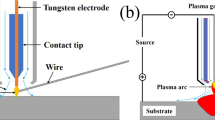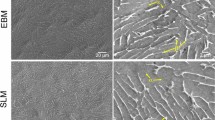Abstract
The aim of this work is to study the metallurgical and mechanical properties of dissimilar assemblies of 2024 T3 and 7075 T6 structural hardening aluminum alloy by the TIG twine electrode arc welding process. It will include a weld performed according to optimized welding parameters followed by a study of the macroscopic and microscopic evolution of the dissimilar assembly (2024-7075) using optical and scanning electron microscopy (SEM); in addition, the phase compositions were analyzed with an energy dispersive spectrometer (EDS). Tensile and microhardness tests were performed. The tensile fracture was observed by SEM. This paper suggests that when the double tungsten electrode TIG welding is used, a stable arc has been formed with a good bead appearance. The heat dissipated by the arc generates several zones (molten zone (WZ), bonding zones (LZ), heat-affected zones (HAZ)) with different microstructures or precipitates of the type θ (Al2 Cu), S (Al2 Cu, Mg) and η (Mg Zn2), S (Al2 Cu Mg) are formed in the heat-affected zone (HAZ) of base metals 2024 and 7075 respectively. The microhardness is lower in the molten zone and higher in the heat-affected zone of 7075 T6 alloy, which cried out an embrittlement and a 44% and 37% drop in the tensile strength of 7075 T6 and 2024 T3 base metals respectively.












Similar content being viewed by others
Data availability
All the data have been presented in the manuscript.
References
Toma CM (2012) Maîtrise des interfaces hétérogènes lors d’une opération de soudo-brasage: application au couple aluminium-magnésium (Doctoral dissertation, Dijon).
Troeger LP, Starke EA Jr (2000) Microstructural and mechanical characterization of a superplastic 6xxx aluminum alloy. Mater Sci Eng A 277(1-2):102–113. https://doi.org/10.1016/S0921-5093(99)00543-2
Al-Roubaiy AO, Nabat SM, Batako AD (2014) Experimental and theoretical analysis of friction stir welding of Al–Cu joints. Int J Adv Manuf Technol 71(9):1631–1642. https://doi.org/10.1007/s00170-013-5563-z
Sheikhi M, Ghaini FM, Assadi H (2015) Prediction of solidification cracking in pulsed laser welding of 2024 aluminum alloy. Acta Mater 82:491–502. https://doi.org/10.1016/j.actamat.2014.09.002
Caiazzo F, Alfieri V, Cardaropoli F, Sergi V (2013) Butt autogenous laser welding of AA 2024 aluminium alloy thin sheets with a Yb: YAG disk laser. Int J Adv Manuf Technol 67(9):2157–2169. https://doi.org/10.1007/s00170-012-4637-7
Cho J, Lee JJ, Bae SH (2015) Heat input analysis of variable polarity arc welding of aluminum. Int J Adv Manuf Technol 81(5):1273–1280. https://doi.org/10.1007/s00170-015-7292-y
Bai JY, Fan CL, Yang CL, Dong BL (2016) Effects of thermal cycles on microstructure evolution of 2219-Al during GTA-additive manufacturing. Int J Adv Manuf Technol 87(9):2615–2623. https://doi.org/10.1007/s00170-016-8633-1
Wang JB, Nishimura H, Katayama S, Mizutani M (2013) Welding of aluminium alloy by using filler-added laser-arc hybrid welding process. Weld Int 27(2):98–108. https://doi.org/10.1080/09507116.2011.600013
Kasman Ş, Yenier Z (2014) Analyzing dissimilar friction stir welding of AA5754/AA7075. Int J Adv Manuf Technol 70(1-4):145–156. https://doi.org/10.1007/s00170-013-5256-7
Song Y, Yang X, Cui L, Hou X, Shen Z, Xu Y (2014) Defect features and mechanical properties of friction stir lap welded dissimilar AA2024–AA7075 aluminum alloy sheets. Mater Des 55:9–18. https://doi.org/10.1016/j.matdes.2013.09.062
Mastanaiah P, Sharma A, Reddy GM (2016) Dissimilar friction stir welds in AA2219-AA5083 aluminium alloys: effect of process parameters on material inter-mixing, defect formation, and mechanical properties. Trans Indian Inst Metals 69(7):1397–1415. https://doi.org/10.1007/s12666-015-0694-6
Hasan MM, Ishak M, Rejab MRM (2017) Influence of machine variables and tool profile on the tensile strength of dissimilar AA7075-AA6061 friction stir welds. Int J Adv Manuf Technol 90(9-12):2605–2615. https://doi.org/10.1007/s00170-016-9583-3
Lakshminarayanan AK, Balasubramanian V, Elangovan K (2009) Effect of welding processes on tensile properties of AA6061 aluminium alloy joints. Int J Adv Manuf Technol 40(3-4):286–296. https://doi.org/10.1007/s00170-007-1325-0
Kobayashi K, Nishimura Y, Iijima T, Ushio M, Tanaka M, Shimamura J, Ueno Y, Yamashita M (2004) Practical application of high efficiency twin-arc TIG welding method (SEDAR-TIG) for PCLNG storage tank. Welding in the World 48(7):35–39. https://doi.org/10.1007/BF03266441
Zhang G, Xiong J, Gao H, Wu L (2012) Effect of process parameters on temperature distribution in twin-electrode TIG coupling arc. J Quant Spectrosc Radiat Transf 113(15):1938–1945. https://doi.org/10.1016/j.jqsrt.2012.05.018
Yamada M (1998) Development of high efficiency TIG welding method. 1st Report of the Japan Welding Society 63:24–25
Kobayashi K, Yuki M, Tejima A, Nishimura Y (2002) Development of high efficiency TIG welding method (SEDAR-TIG). Ishikawajima-Harima Giho 42(3):127–132 http://pascal-francis.inist.fr/vibad/index.php?action=getRecordDetail&idt=13700607
Wang S, Zhang H, Leng X, Wu, L. (2007) Twin-electrode TIG welding procedure and mechanism of weld formation. Transactions-China Welding Institution 28(2):21
Wang X, Fan D, Huang J, Huang Y (2014) A unified model of coupled arc plasma and weld pool for double electrodes TIG welding. J Phys D Appl Phys 47(27):275202. https://doi.org/10.1088/0022-3727/47/27/275202
Ding X, Li H, Yang L, Gao Y, Wei H (2014) Numerical analysis of arc characteristics in two-electrode GTAW. Int J Adv Manuf Technol 70(9-12):1867–1874. https://doi.org/10.1007/s00170-013-5443-6
Schwedersky MB, Gonçalves e Silva RH, Dutra JC, Reisgen U, Willms K (2016) Two-dimensional arc stagnation pressure measurements for the double-electrode GTAW process. Sci Technol Weld Join 21(4):275–280. https://doi.org/10.1080/13621718.2015.1104095
Ogino Y, Hirata Y, Nomura K (2011) Numerical analysis of the heat source characteristics of a two-electrode TIG arc. J Phys D Appl Phys 44(21):215202. https://doi.org/10.1088/0022-3727/44/21/215202
Puydt Q (2012) Comportement mécanique de soudures en alliage d’aluminium de la série 7xxx: de la microstructure à la modélisation de la rupture (Doctoral dissertation, Institut National Polytechnique de Grenoble-INPG).
Bousquet E (2011) Durabilité des assemblages soudés par friction stir Welding (FSW) Corrélation entre microstructure et sensibilité à la corrosion (Doctoral dissertation, Ph. D. thesis, Université Bordeaux 1).
Lin YC, Xia YC, Jiang YQ, Zhou HM, Li LT (2013) Precipitation hardening of 2024-T3 aluminum alloy during creep aging. Mater Sci Eng A 565:420–429. https://doi.org/10.1016/j.msea.2012.12.058
Cochard A, Zhu K, Joulié S, Douin J, Huez J, Robbiola L, Sciau P, Brunet M (2017) Natural aging on Al-Cu-Mg structural hardening alloys–Investigation of two historical duralumins for aeronautics. Mater Sci Eng A 690:259–269. https://doi.org/10.1016/j.msea.2017.03.003
Kaçar H, Atik E, Meriç C (2003) The effect of precipitation-hardening conditions on wear behaviours at 2024 aluminium wrought alloy. J Mater Process Technol 142(3):762–766. https://doi.org/10.1016/S0924-0136(03)00642-3
Lefebvre F, Ganguly S, Sinclair I (2005) Micromechanical aspects of fatigue in a MIG welded aluminium airframe alloy: Part 1. Microstructural characterization. Mater Sci Eng A 397(1-2):338–345. https://doi.org/10.1016/j.msea.2005.02.051
Rhodes CG, Mahoney MW, Bingel WH, Spurling RA, Bampton CC (1997) Effects of friction stir welding on microstructure of 7075 aluminum. Scr Mater 36(1):69–75
Kaufman JG (2000) Introduction to aluminum alloys and tempers. ASM international.
Kou S (2003) Welding metallurgy second edition. Hoboken, New Jersey, 1-29.
Alfieria V, Caiazzoa F, Sergi V (2015) Autogenous laser welding of AA 2024 aluminium alloy: process issues and bead features. Procedia Cirp 33:406–411. https://doi.org/10.1016/j.procir.2015.06.094
Rosalie JM, Bourgeois L (2012) Silver segregation to θ′(Al2Cu)–Al interfaces in Al–Cu–Ag alloys. Acta Mater 60(17):6033–6041. https://doi.org/10.1016/j.actamat.2012.07.039
Norman AF, Drazhner V, Prangnell PB (1999) Effect of welding parameters on the solidification microstructure of autogenous TIG welds in an Al–Cu–Mg–Mn alloy. Mater Sci Eng A 259(1):53–64. https://doi.org/10.1016/S0921-5093(98)00873-9
Elrefaey A (2015) Effectiveness of cold metal transfer process for welding 7075 aluminium alloys. Sci Technol Weld Join 20(4):280–285. https://doi.org/10.1179/1362171815Y.0000000017
Kalita SJ (2011) Microstructure and corrosion properties of diode laser melted friction stir weld of aluminum alloy 2024 T351. Appl Surf Sci 257(9):3985–3997. https://doi.org/10.1016/j.apsusc.2010.11.163
Jalilvand V, Omidvar H, Khorrami H (2014) Effect of welding parameters on the mechanical properties of AA2024 aluminium alloy joints welded by resistance seam welding. Can Metall Q 53(2):117–124. https://doi.org/10.1179/1879139513Y.0000000110
Saravanan V, Rajakumar S, Banerjee N, Amuthakkannan R (2016) Effect of shoulder diameter to pin diameter ratio on microstructure and mechanical properties of dissimilar friction stir welded AA2024-T6 and AA7075-T6 aluminum alloy joints. Int J Adv Manuf Technol 87(9):3637–3645. https://doi.org/10.1007/s00170-016-8695-0
Padmanaban R, Balusamy V, Vaira Vignesh R (2020) Effect of friction stir welding process parameters on the tensile strength of dissimilar aluminum alloy AA2024-T3 and AA7075-T6 joints. Mater Werkst 51(1):17–27. https://doi.org/10.1002/mawe.201800184
Avinash P, Manikandan M, Arivazhagan N, Ramkumar KD, Narayanan S (2014) Friction stir welded butt joints of AA2024 T3 and AA7075 T6 aluminum alloys. Procedia Eng 75:98–102. https://doi.org/10.1016/j.proeng.2013.11.020
Menan F (2008) Influence de la corrosion saline sur la tolérance aux dommages d’un alliage d’aluminium aéronautique 2XXX. Doctoral dissertation, Poitiers
Acknowledgements
The authors wish to express their sincere appreciations to the Research Center in Industrial Technologies (CRTI) and Special thanks to the Laboratory of Science and Materials Engineering (LSGM).
Author information
Authors and Affiliations
Contributions
All authors contributed to the research, writing, and reviewing of the paper.
Corresponding author
Ethics declarations
Ethics approval
Not applicable.
Consent to participate
Not applicable.
Consent to publish
The authors give all the rights to publish the material presented in this work.
Competing interests
The authors declare no competing interests.
Additional information
Publisher’s note
Springer Nature remains neutral with regard to jurisdictional claims in published maps and institutional affiliations.
Rights and permissions
About this article
Cite this article
Kaba, L., Djeghlal, M.E., Ouallam, S. et al. Dissimilar welding of aluminum alloys 2024 T3 and 7075 T6 by TIG process with double tungsten electrodes. Int J Adv Manuf Technol 118, 937–948 (2022). https://doi.org/10.1007/s00170-021-07888-5
Received:
Accepted:
Published:
Issue Date:
DOI: https://doi.org/10.1007/s00170-021-07888-5




